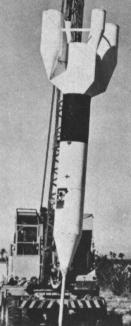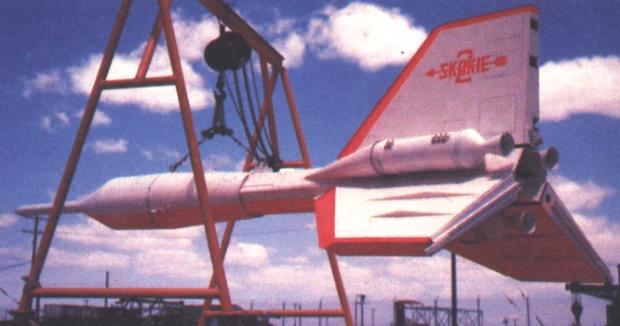Cook Skokie
The Cook Skokie I and Skokie II research vehicles were used by the U.S. Air Force to test high-speed parachute recovery systems during the mid-1950s.
 |
 | |
| Photo: via Ordway/Wakeford | Photo: USAF | |
| Skokie I | Skokie II |
The unpowered Skokie I was released at about 10 km (6 miles) altitude from a B-29 carrier aircraft. After release, the test parachute was deployed from the tail, and during the following five-second drop, the Skokie's instruments recorded data to determine the rate of descent and the parachute's drag force. The parachute was also monitored by a high-speed camera. After the test parachute was released, the vehicle fell free until it was recovered by its two-stage main parachute system. It landed nose down on a spike to prevent major damage to the vehicle. The Skokie I could test parachute systems at speeds in the high-subsonic region. The Skokie II, which was of completely different external configuration, followed a similar procedure, but was powered by three solid-propellant rocket motors for speeds of almost Mach 2.
Specifications
Note: Data given by several sources show slight variations. Figures given below may therefore be inaccurate!
Data for Skokie:
| Skokie I | Skokie II | |
|---|---|---|
| Length | 7.6 m (25 ft) | 9.8 m (32 ft) |
| Diameter | 51 cm (20 in) | ? |
| Weight | 1100 kg (2400 lb) | 1360 kg (3000 lb) empty |
| Speed | < Mach 1 | < Mach 2 |
| Propulsion | none | 3x solid-fueled rocket; 49 kN (11000 lb) each |
Main Sources
[1] Frederick I. Ordway III, Ronald C. Wakeford: "International Missile and Spacecraft Guide", McGraw-Hill, 1960
[2] Norman J. Bowman: "The Handbook of Rockets and Guided Missiles", Perastadion Press, 1963
Back to Directory of U.S. Military Rockets and Missiles, Appendix 4
Last Updated: 21 October 2003